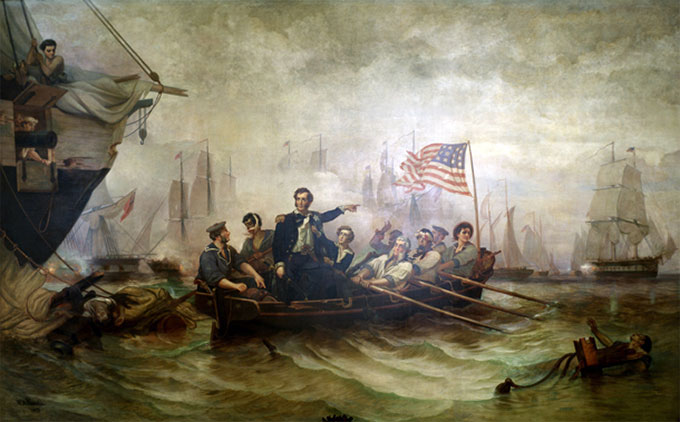"We Have Met the Enemy, and They Are Ours"
by Mason Winfield

The Battle of Lake Erie, Put-In-Bay off Sandusky, Ohio, September 10, 1813
The War of 1812 had three frontiers, on the three basic directions from which the British could get at the young United States. Two of them were by water, on the Atlantic coast and the Gulf of Mexico. The third was overland from Canada, usually crossing inland water. The war’s only sustained land fighting was along the 30-mile strait they call the Niagara River.
By summer 1813, the Americans held the Canadian side of the Niagara. They had both Forts George and Niagara, bookends across the rivermouth where it meets Lake Ontario. Things were soon fraying for them, and they weren’t much good anywhere else.
British ships had the run of the Great Lakes, controlling trade and traffic and terrorizing civilians. Close to home, the Queen Charlotte was a nightmare on the Erie lakeshore. She pelted farmers in their fields in Derby and Hamburg. People still find the occasional cannonball. Once she dropped off crews who looted a lakeside tavern and warehouse (probably those of Job Palmer) just across Eighteen-Mile Creek from the someday site of Frank Lloyd Wright’s Greycliff. Then one tiny clash—15 ships!—in Lake Erie waters east of Cleveland turned things upside down.
The sides in what’s often called the Battle of Put-In Bay seemed even. Both lamented the shortage of seasoned sailors and war materials. Both ducked battle for weeks and fought only when they had to, the British when their supply lines were stressed and the Americans when they were attacked. The British had bigger ships and the only true warship (the Detroit), but the US had more (nine). The British had bigger guns, the US had more. The British had experience, but the US had “The Hero of Lake Erie,” dynamic young Commodore Oliver Hazard Perry (1785-1819). His roots were warlike. His mother Sarah Wallace Alexander is believed a direct descendant of medieval Scottish hero William Wallace, the original “Braveheart.”
This was a ferocious scrap. Aware that the British were approaching their anchorage near Sandusky, Ohio, the Americans pulled out to meet them around noon on September 10. The British long guns pounded Perry’s flagship, the Lawrence, before its cannon were in range. While smaller ships on both sides sniped away, Perry rushed in and engaged the Empire’s two biggest, the Detroit and the Queen Charlotte. Two British commanders were quickly hit and incapacitated. The Lawrence was so damaged that it was helpless. The British thought they had won. Perry just switched ships. He crossed half a mile of open water in a rowboat under fire, boarded the Niagara, and attacked again. In the chaos, the Detroit and the Queen Charlotte bumped and got entangled. There’s one for Derby! The British surrendered.
The ships were in the handfuls, the combatants in the hundreds, and the deaths in the dozens, but a balance had shifted, all over the northeast. Why?
The answer lies in several of the day’s dynamics. One concerned food. In the age of low-yield agriculture and low-tech preservation, no large body of men could carry or confiscate all it needed. Maintaining forts or armies meant keeping supply lines open, constantly.
Transportation was another factor. Land travel in the Great Lakes region was abysmal. Heavy cargo went by water, hence military thinking depended on controlling water lanes, often with strategic forts. Holding the right lake or river-mouth meant that you thrived and somebody else starved. If, however, your own lifeline was cut…
Keep your fort—if you can eat it.
That was the significance of the Battle of Put-In-Bay. Since western access to the 1812 war’s northern theater and population centers was through Lake Erie, once the British lost their fleet there, they gave up the western Great Lakes. They abandoned their forts. Their armies fled back to Ontario. Their Native American coalition collapsed. The US’s whole interior was freed from the fear of attack.
The War of 1812 has left us with so many capital lines that you’d swear it was a major conflict. Among them is the title of this article taken from Perry’s quick note on the Battle of Lake Erie, which had other fallout. Master Commodore Jesse Elliott (1782-1845), a hero for 11 months, had held his ship the Niagara on the skirts of the battle and let Perry fight the first half solo. Either he got mixed signals (as he claimed) or he was pouting that Perry had been promoted over him. Neither would have been unique in this war. Some furious junior officers accused Elliott of hanging everyone out to dry, and the matter developed into a scandal and a feud that would plague him for the rest of his life.
The British post-mortem was prosaic. It ruled that their own Captain Robert Barclay had acted reasonably and that the taut battle had been decided by the Americans’ moderate edge in total lead-slinging, which is probably fair. All battles are settled by some kind of material advantage. Leave righteous causes and national valor to the cheerleaders.
The founder of Haunted History Ghost Walks, Inc., Mason Winfield is the author of 10 books including Ghosts of 1812 (2009), published by Western New York Wares.
blog comments powered by Disqus|
Issue Navigation> Issue Index > v12n35 (Week of Thursday, August 29) > "We Have Met the Enemy, and They Are Ours" This Week's Issue • Artvoice Daily • Artvoice TV • Events Calendar • Classifieds |









 Current Issue
Current Issue